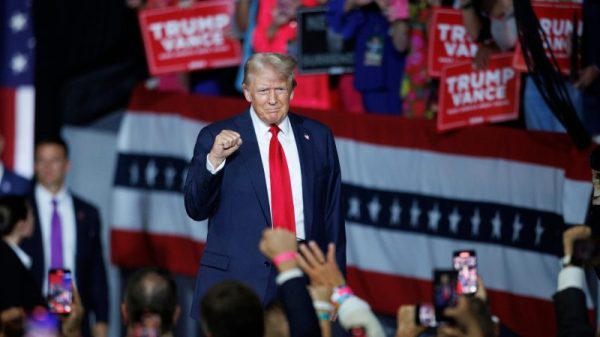An earlier version of this story referred inaccurately to the process by which North Carolina passed a state constitutional amendment requiring a voter ID. The amendment was put on the ballot by the General Assembly and then voters approved it. The General Assembly did not amend the constitution directly. The story has been updated.
When Juliana Buonaiuto moved from New York to attend Kent State University in 2020, she had her heart set on voting in her college community in Ohio.
“I wanted my vote to count where I was living,” Buonaiuto said.
Four years later, Buonaiuto is planning to vote absentee in New York, in part because of an Ohio elections law championed by Republicans that can make it more challenging for out-of-state students to cast ballots.
The legislation, which was signed into law by Republican Gov. Mike DeWine last January, introduced significant changes to Ohio’s election laws, most notably establishing a photo ID requirement that is considered among the most restrictive in the nation. DeWine argued the bill would improve “election integrity,” and a federal judge shot down a Democratic attempt to block it, saying the law “imposes no more than a minimal burden, if any, for the vast majority of voters.”
But some Ohio college students say that they are the exception, and that the legislation fits within a nationwide Republican effort in recent years to restrict their voting rights.
After voting rules were loosened in many states for the 2020 election, which was held in the depths of the coronavirus pandemic, GOP lawmakers have sought to tighten restrictions for 2024. Although the efforts have been ostensibly aimed at curbing fraud, elections experts say voter fraud is already exceedingly rare. Democrats say they believe the real objective is to limit voting among college students, who voted in historic numbers in 2020 and overwhelmingly supported Joe Biden, helping to power his victory.
“We need to be seeing this law for what it really is,” said Katie Seewer, president of the Ohio State College Democrats. “It’s an attack on students and an attack on their ability to vote.”
College campuses have become sources of strength for Democratic candidates. Some allies of former president Donald Trump have bemoaned the ease with which students can vote and advocated making it more difficult.
“What is this young people effort that they do? They basically put the polling place next to the student dorm so they just have to roll out of bed, vote, and go back to bed,” longtime Republican lawyer and strategist Cleta Mitchell told GOP donors last spring.
Liz Avore, a senior policy adviser tracking election-related legislation at the nonpartisan organization Voting Rights Lab, said she has seen “a divide develop and deepen between states” when it comes to voting policy during the last four years. Student voting access changes have been part of that, she said. The legislation has come from “states that are looking to remove barriers to student voting and by states that are looking to restrict access to voting by students.”
In Democratic-led states such as New York or Colorado, for instance, lawmakers have passed bills that will likely lead to easier access to polling places on college campuses. Several Republican-led states have moved in the other direction.
Voters in Idaho, for example, can no longer use student ID cards at the polls. The state legislature removed ID cards issued by high schools and institutions of higher education from the eligibility list with a bill that went into effect on Jan. 1. Numerous other forms of identification, including concealed weapons licenses, remain acceptable.
The Republican-dominated North Carolina General Assembly put a constitutional amendment on the ballot to implement a voter ID requirement, and voters approved it in 2018. The measure was blocked by the state Supreme Court, but the court reversed its decision last year after Republicans secured an elected majority and the photo ID law is now in effect. Student IDs do not necessarily meet the criteria, and it is up to schools and universities to bring them in compliance with the law’s standards.
Unlike North Carolina, Ohio, which has chosen a Republican for president in the last two cycles, is not expected to be competitive in the 2024 presidential race. But the state, which has a March 19 primary, features a critically important Senate election. In a state of nearly 12 million people, Ohio has more than 600,000 college students, making them a potentially important constituency — if they vote.
That can be more complicated than it used to be.
Buonaiuto, who is now the student body president at Kent State, chose to vote in New York rather than Ohio in 2020 because of increased absentee voting options in her home state. This year, she plans to vote in New York again, in part because the new Ohio law would require her to give up her New York-issued ID for one issued by Ohio if she wants to vote in person.
The new Ohio law restricts the types of acceptable voter ID cards to Ohio driver’s licenses and state ID cards, U.S. passports and passport cards, U.S. military ID cards, Ohio National Guard ID cards and U.S. Department of Veterans Affairs cards. The bill also removed the cost to obtain state-issued ID cards for state residents 17 and older.
Students at public universities in Ohio could previously vote with their student ID card if it met certain criteria, said Aaron Ockerman, the executive director of the Ohio Association of Election Officials.
Ohioans could also prove their identity with utility bills at the polls under the previous law, so Ockerman said private universities would create utility bills for their students living in dorms with which to vote.
“A lot of the out-of-state college students don’t want to get an Ohio driver’s license or an Ohio-issued photo ID because it would then impact their driving privileges back in their home state where they’re very likely to return,” Ockerman said. “So they kind of get caught in this catch-22 where they’re required to have this current valid Ohio driver’s license or identification.”
Ockerman said he has noticed college campuses and voting rights groups encouraging out-of-state students to vote by absentee ballot in Ohio instead. The identification standard for mail-in absentee ballots in Ohio is different from regular ballots, Ockerman said, with voters using the last four digits of their Social Security number to prove their identity rather than photo IDs.
The new law has found support on campuses among Republican students.
“It increases election integrity and raises barriers to potentially questionable election practices,” said Carter Long, president of the College Republicans at Xavier University in Cincinnati. “Previously college students only had to have a utility letter and then their student ID to vote, which can be relatively easily forged.”
Republican officials who backed the law described it as a logical way to shore up voting rules.
“Ohioans are clearly supportive of strict photo ID for voting and we have found a common-sense way to make it happen that ensures voters are not disenfranchised,” Secretary of State Frank LaRose (R), who is now a candidate for Senate, said in a statement at the time of the law’s passage. “No piece of legislation is a silver-bullet solution, but we are once again showing Ohioans that we take their concerns seriously and are dedicated to continuously improving our elections.”
Democrats, however, decried the law, alleging that it imposed “needless and discriminatory burdens.” The Kent State undergraduate student government passed a resolution condemning the changes and urging a repeal.
“We personally feel like it is a hurdle for students and that it suppresses voting rights for students and dilutes the youth vote,” said Buonaiuto, who supported the resolution.
Buonaiuto is working with other members of the student government to educate students about how to vote in Ohio, which she said could be confusing even before the latest changes. The polling locations on the Kent State campus, for instance, are only available for students living in residence halls, meaning students in off-campus housing need to vote elsewhere.
Lily Evans, the governmental relations legislative coordinator for Ohio State University’s undergraduate student government, said she fears the overall impact of the new law may be diminished turnout. Evans said she has a friend from Illinois who previously voted using her campus address but told Evans she is choosing not to vote at all because she doesn’t have an Ohio-issued ID.
“It’s not that it makes it incredibly difficult,” she said, “just difficult enough that a lot of students that I have heard of are not going to go out and vote.”





























